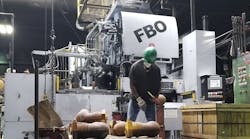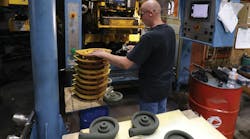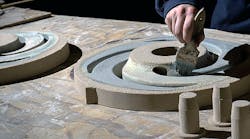NEXEN GROUP INC. offers two models of DFC Pilot Mount Clutches (DFC-1650 and DFC-2200) for foundry applications — self-contained, dual-faced, air-engaged friction clutches with bearing-mounted plate (pilot) for mounting pulleys or sprockets. Both models are self-contained, dual faced, air-engaged friction clutches with a bearing-mounted plate (pilot) for mounting pulleys or sprockets. Two sizes fit shafts up to 3.375 inches, and designed for shaft-end mounts only. DFC clutches are capable of speeds up to 1,200 rpm and thermal horsepower dissipation of up to 10 horsepower.
Mullers are used to prepare molding sands, involving intensive mixing using controlled pressure and agitation through a compression, shearing, and blending action. That effect is produced from a tool set consisting of a combination of muller wheels and plows. The process is necessary to green-sand casting operations in order to thoroughly coat grains of sand with clay, to make it sticky enough for effective molding.
Modern mullers, coupled with advanced control and automation systems produce close-tolerance molding sand cost-effectively, using “air engaged clutches” mounted on the motor shaft driving the sand mixing process. A clutch with a sheave is installed onto the motor shaft, and the motor and the clutch are mounted on a platform located to the side of the muller. Drive belts connect the clutch sheave to the driven sheave on the muller roller arm and shaft.
The shaft carries the rollers and plows that stir the sand. The forces acting on the shaft are those acting on the rollers which are transmitted to the shaft. These forces include the reaction due to weight of rollers, reactions due to compression strength of molding sand and centrifugal effect on both rollers and shaft.
Nexen reports it frecquently has replaced failing competitors’ clutches on foundry mullers, as they are frequently unable to provide clutches with the bearing and facing life that are needed for the demanding operation.
Nexen DFC Pilot Mount Clutches operate with an air-pressurized piston moving axially to compress the friction facing against the inside of a dual-faced rotor, which is splined to a shaft-mounted hub. The rotor is locked with the pilot plate, under friction, to transmit power from the driving shaft to the driven pulley or sprocket. Torque is transmitted by the splined pressure plates and friction discs to the splined hub that’s keyed to the shaft. The splines provide excellent alignment and low friction resistance for fast engagement and disengagement.
Air pressure pushes the piston and splined pressure plate against the disc assembly engaging the friction surface of the discs with the friction facings. Springs return the plate and pistons to the disengaged position when air exhausts from the cylinder. Fins on the pressure plate and hub dissipate heat generated at the interfaces. Maximum cooling is attained when the discs and hub are mounted on a continually running shaft.
The DFC’s simple piston and cylinder actuator is sealed with Viton O-rings for easy servicing, lowering maintenance costs compared to designs with large air bladders. These products are also designed with segmented, non-asbestos, friction facings for easy replacement and free-flow of cooling air. Low inertia friction discs reduce load acceleration times.
DFC Pilot Mount Clutches (models 1650/2200) offer:
• Static torque (at 80 psi): 36,000/66,800 in./lbs.;
• Maximum speed: 1200/900 RPM;
• Effective facing area: 227 in2 /330 in2;
• Peak input rate: 204/297 HP;
• Viton seals;
Learn more at www.nexengroup.com









